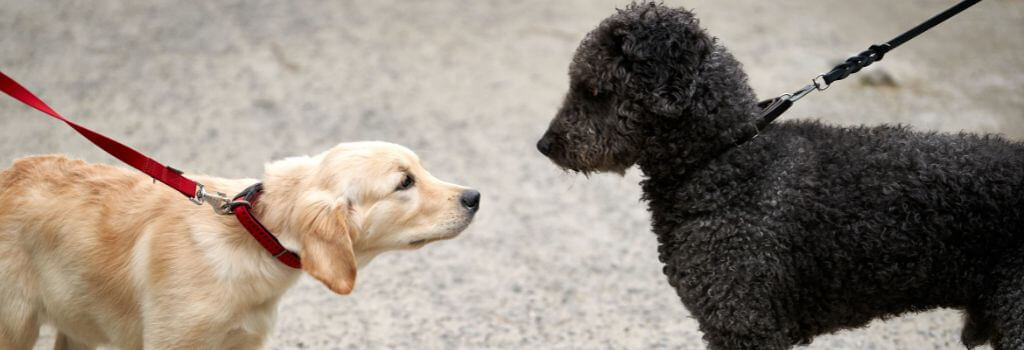Introducing dogs to one another may seem simple, but without the right approach, these interactions can go wrong quickly and result in a number of socialization issues for your dog later in life.
Dogs rely heavily on body language and vocalizations for communication, and a structured introduction in a controlled environment allows them to establish boundaries and safely ease into new relationships with other dogs. Teaching your dog the right way to behave around unfamiliar animals can create a strong foundation of good behavior and avoid issues associated with reactivity and aggression. In this blog, we'll cover a few best practices to help you navigate making new friends for your dog with ease.
Why a Proper Introduction Is Important
You've probably heard that first impressions matter, and while that saying is typically used in the context of human relationships, it's something that applies well to dogs, too!
Dogs are highly social creatures that enjoy companionship and the company of both humans and other animals alike. How much time a dog needs to spend among other dogs will vary from dog to dog and cannot be generalized based on breed, age, or any other factors, but veterinarians and behaviorists typically recommend that a dog have exposure to other dogs for at least a few hours a week. So whether it's being a regular at a dog park or having a multi-dog household, spending time with other dogs is an important part of a healthy and happy life for all dogs. This means it's important that dog owners know how to properly facilitate a meet and greet and that their dog knows exactly what to expect when making a new friend.
Nailing introductions and having your dog successfully meet and interact with other dogs in public spaces or even your own home has numerous benefits, including:
- Preventing Aggression and Fear Around Other Dogs and Animals
- Reducing Social Stress and Anxiety
- Associating Other Dogs and Animals with Positive Feelings
- Minimizing Territorial Behavior
- Helping Your Dog Establish Boundaries

Proper socialization during puppyhood is crucial for setting a good foundation for your dog's behaviors and reactions to other dogs. Socialization and exposure to other people and animals are said to be most important when a puppy is between 3 and 14 weeks old. Understanding how to introduce your puppy to other dogs safely will help them grow into a happy and well-adjusted dog and help you avoid issues with reactivity and aggression later in life.
But missing out on socialization during the formative puppy period doesn't mean there's no hope for your dog. In fact, older dogs can pick up on socialization and behavioral training later in life, too, but it may just take a little extra work and patience.
Whether you're just starting to work on socialization or working to reinforce it, introducing new dogs to one another is something that's pretty unavoidable if you're keeping up with your dog's social needs. To keep all of your encounters safe, we've broken down some best practices for introducing two dogs and have shared some of our best tips and tricks.
How Should I Introduce My Dog To A New Dog For The First Time?
Start Small and Work Your Way Up to Proper Introductions
For dogs who are still working on socialization or don't have much experience around other dogs, starting small and working your way up to meeting other dogs face-to-face is a great option to gauge how your dog reacts and behaves. You can start by taking your dog on walks in the vicinity of other dogs. For example, walking your dog around your neighborhood or on a local walking trail presents a great opportunity to see other dogs in their yards on walks with their owner, allowing your dog to observe from a safe distance and get used to the idea of sharing their space with other dogs.
Pick the Right Location
Location is an important consideration when introducing two dogs to one another. It's typically best to choose a neutral location, like a park or unfamiliar outdoor space, to avoid any territorial behavior from either dog. Selecting an outdoor location is often optimal as you'll have plenty of room to keep the dogs at a safe distance when they're first meeting, and in case of something going awry, you'll have plenty of space to pull dogs away if one begins showing signs of aggression, fear, or anxiety.
And if everything goes well, you'll already be in the perfect space for the dogs to get some play time together – a win-win!
Bring the Right Gear
In order to facilitate a smooth introduction, you'll need to bring a few things with you. One non-negotiable thing you'll need for each dog is a strong leash, preferably between four and six feet in length, so that the dogs have a little room to move around as needed during their interaction. In order to maintain proper control during the meeting, you'll want to avoid retractable leashes and stick to regular nylon or leather leashes that are strong to withstand some pulling.
Next, you'll want to have some kind of high-value treat on hand to reward – and encourage – good behavior. Positively reinforcing your dog's good behavior around other dogs helps to teach them good manners and associate similar introductions later in life with a positive experience.
Play Your Part in the Introduction
As an owner, you've got an important role to play when dogs are meeting for the first time. Dogs can often pick up on their owner's emotions, sensing their energy and mood, so it's important for you to keep it cool, calm, and collected throughout the entire meeting. You want to make this as positive an experience as possible, so try keeping your voice upbeat, and give your dog praise and reassurance where appropriate.
In addition to being a comforting and positive presence, you're also responsible for keeping your dog under control. Your dog should have your complete and undivided attention, so avoid any distractions like your phone or deep conversations with the other pet owner. A part of being in control of your dog is managing their leash while they interact with their new friend, you'll need to manage the amount of slack based on how the introduction is going; don't be afraid to let them have a little room if things are going well, or to reel them in if they seem afraid or agitated.

Don't Force Things
One of the most important things to avoid when introducing dogs is forcing interactions. While we may want our dogs to be social butterflies and immediately get along with every dog they meet, that's just not a realistic expectation. So many factors can affect how dogs feel when meeting another animal for the first time, and some days, your dog may be in a weird mood and not up for socializing. It's important to pay close attention to how your dog is feeling and responding to the situation through their body language and vocalizations.
Have a Back-Up Plan Ready
Not every initial introduction will go off without a hitch, so it's always a great idea to have a backup plan. If the dogs are communicating that they don't want to meet, it may be a good idea to try another day or after some additional training; alternatively, if things are off to a little bit of a rocky start, it may be helpful to separate the dogs and have them do some activities in the same space. This can be helpful because while minor disagreements and communication through body language are normal, things can escalate in some situations, and you'll need to break the dogs apart. However, still having them in the same space can help them be a little more comfortable and make this socialization attempt more positive and worthwhile.
Watch Both Dog's Body Language and Reactions
While dogs can't exactly tell us how they're feeling when meeting another dog, we can get some helpful clues from their body language and vocalizations throughout the interaction. Being in tune with your dog's emotions and being able to accurately read physical signs from them can help you avoid
Signs That The Introduction Is Going Well
- Relaxed Body Language
- Wagging Tails at Mid-Level
- Playful Bows
- Calm Sniffing
- Taking Turns Approaching and Backing Away
Warning Signs That The Dogs Aren't Getting Along
- Stiff Posture
- Prolonged Staring or Eye Contact
- Raised Fur Along Their Backs
- Growling or Frightened Vocalizing
- Snapping or Lip Curling
- Tucking Tails Between Their Legs
If you're unsure about how your dog will react when meeting other dogs or have questions about your dog's behavior after an introduction, don't be afraid to reach out to your veterinarian or trainer. Veterinary professionals know dogs well and can often read their body language and understand their behaviors better than many owners. They'll be able to let you know if any behaviors or reactions are a cause for concern and can point you in the right direction if additional help is needed, like with an animal behaviorist.
If you have questions and you'd like to reach out to us, you can call us directly at (480) 614-9500, or you can email us at [email protected]. Don't forget to follow us on social media Facebook, Instagram.
